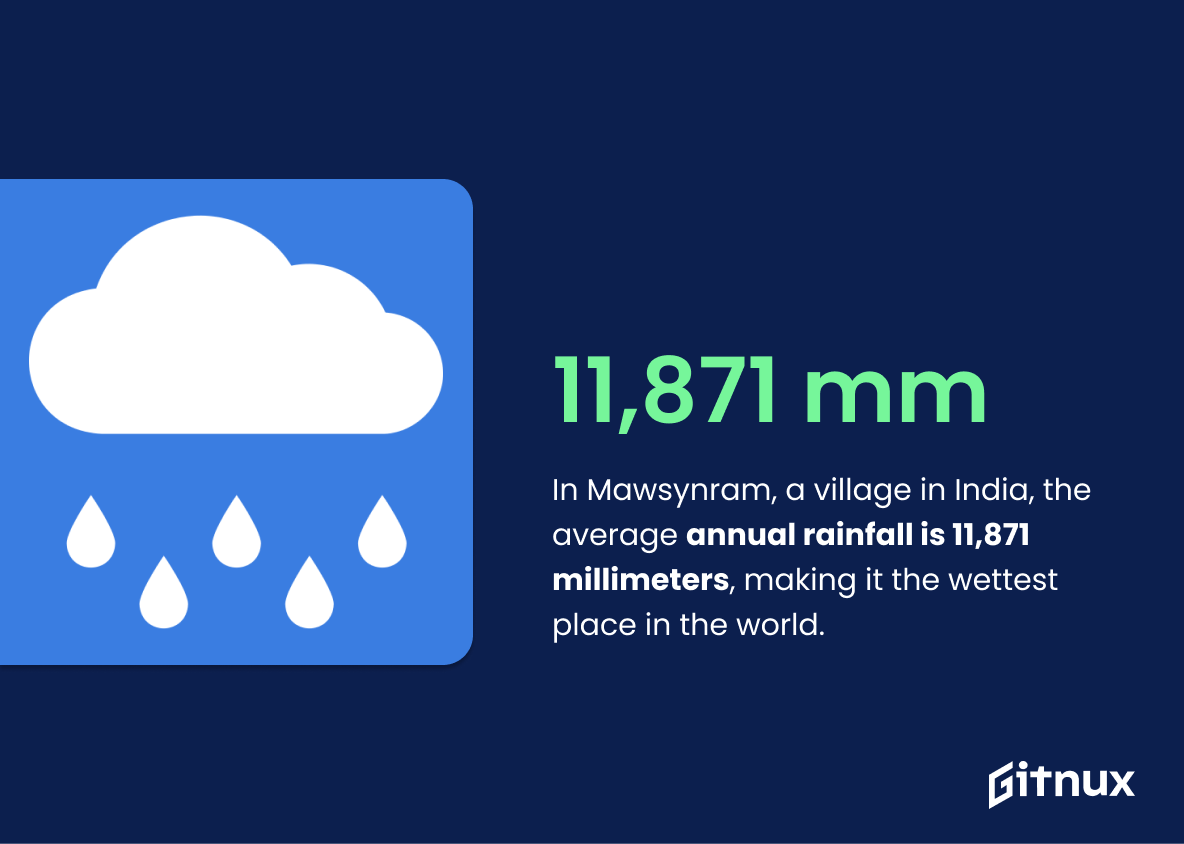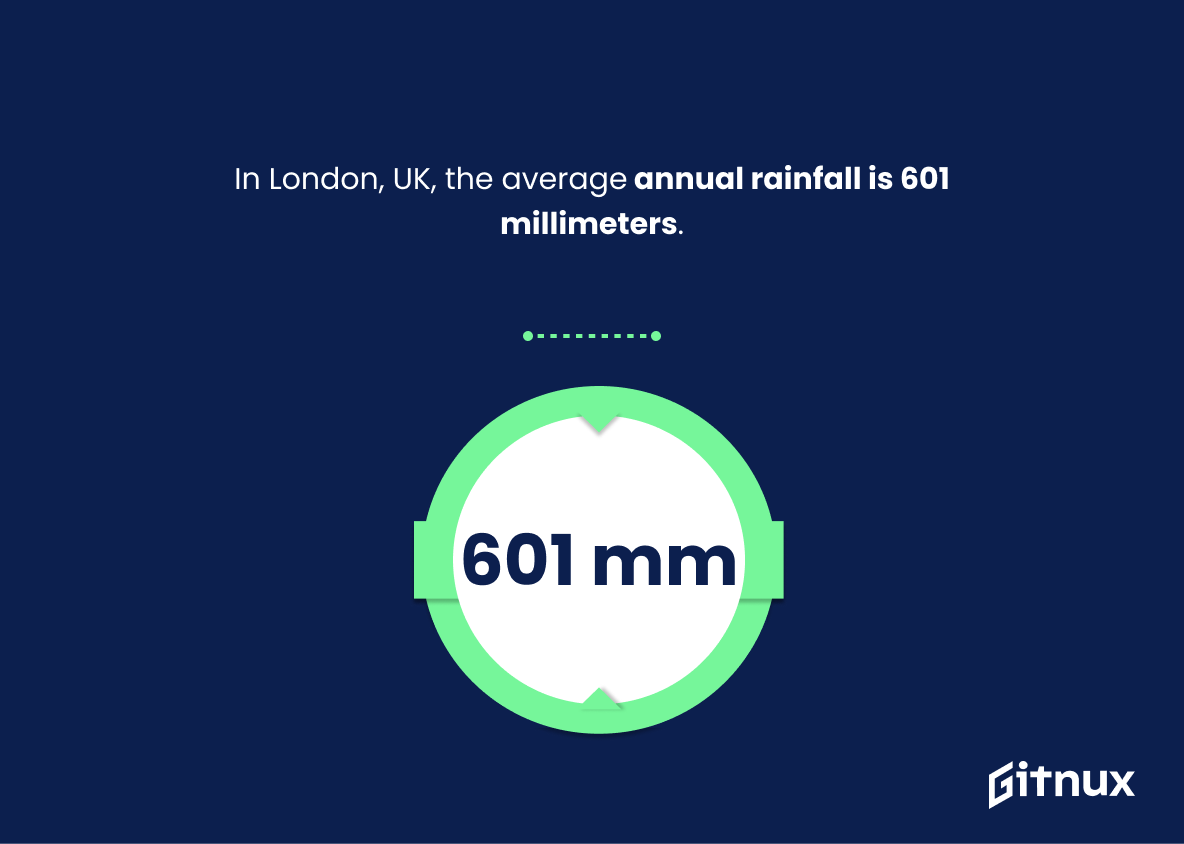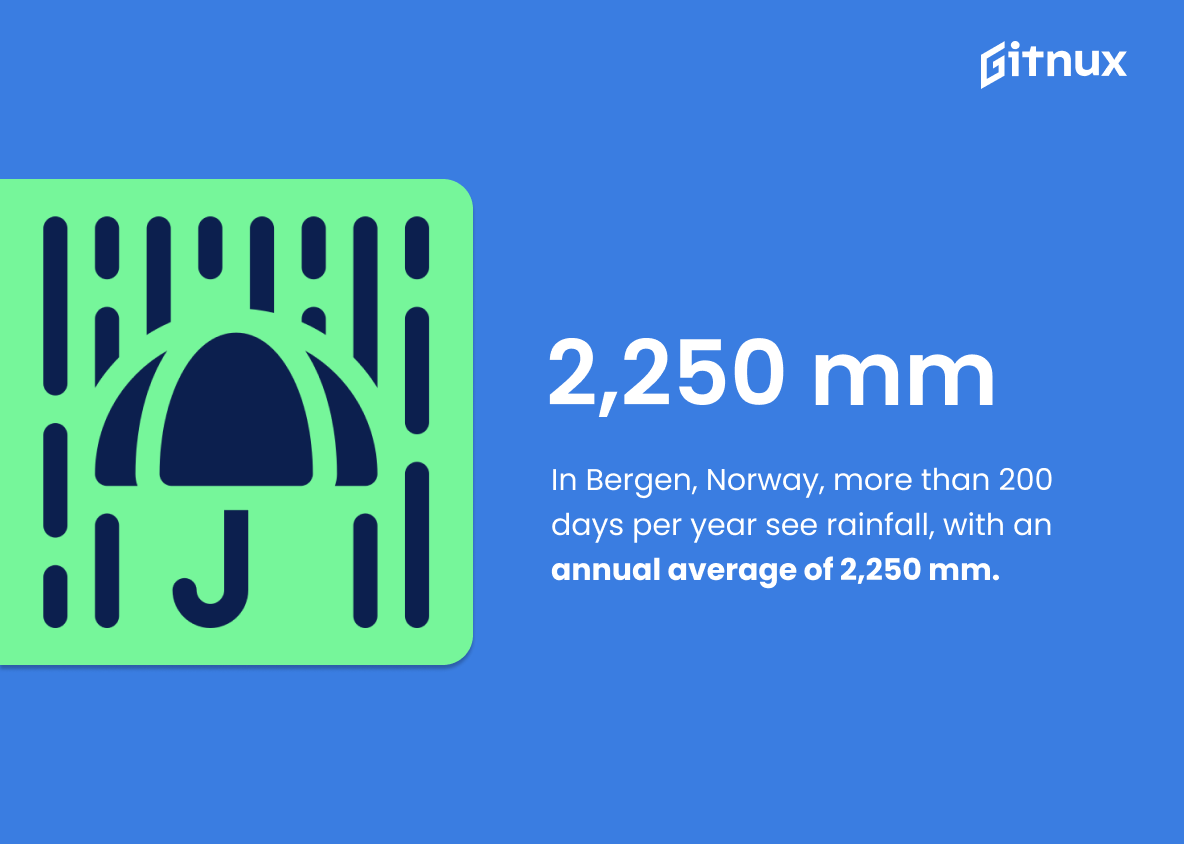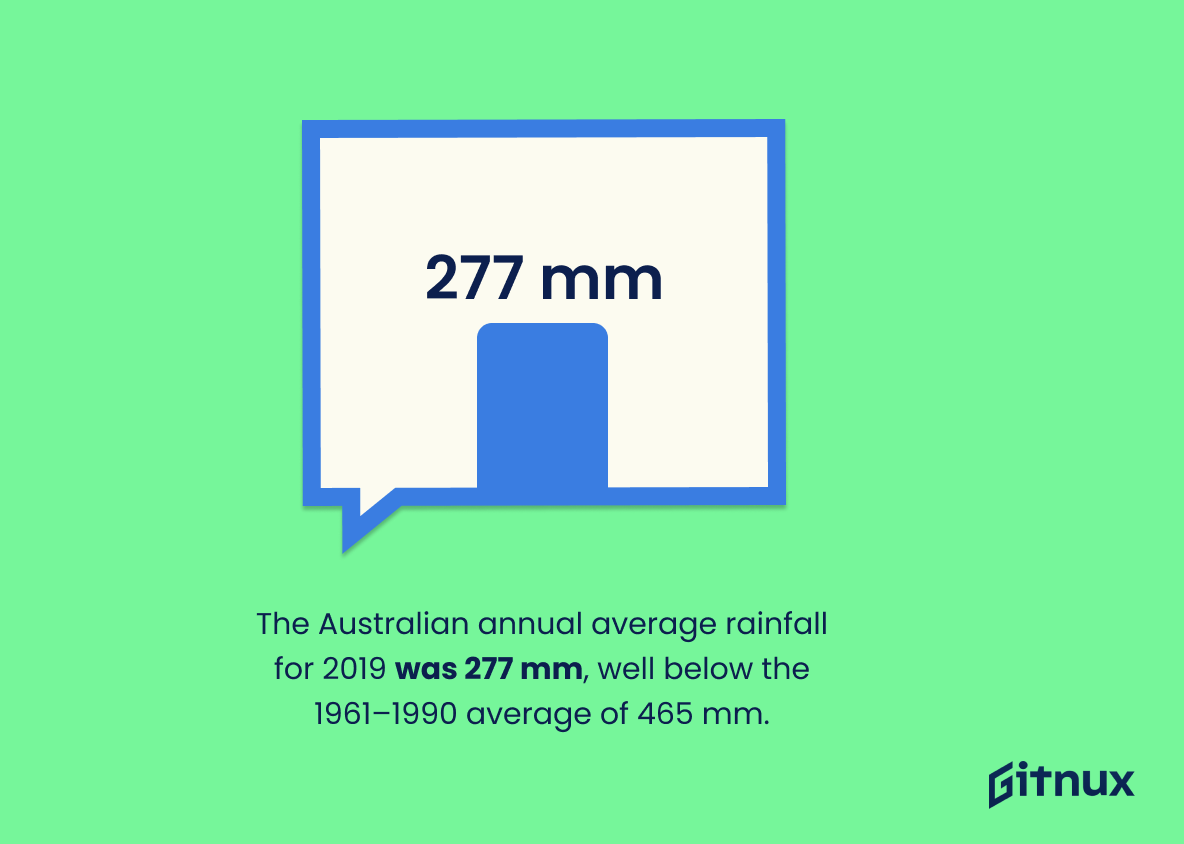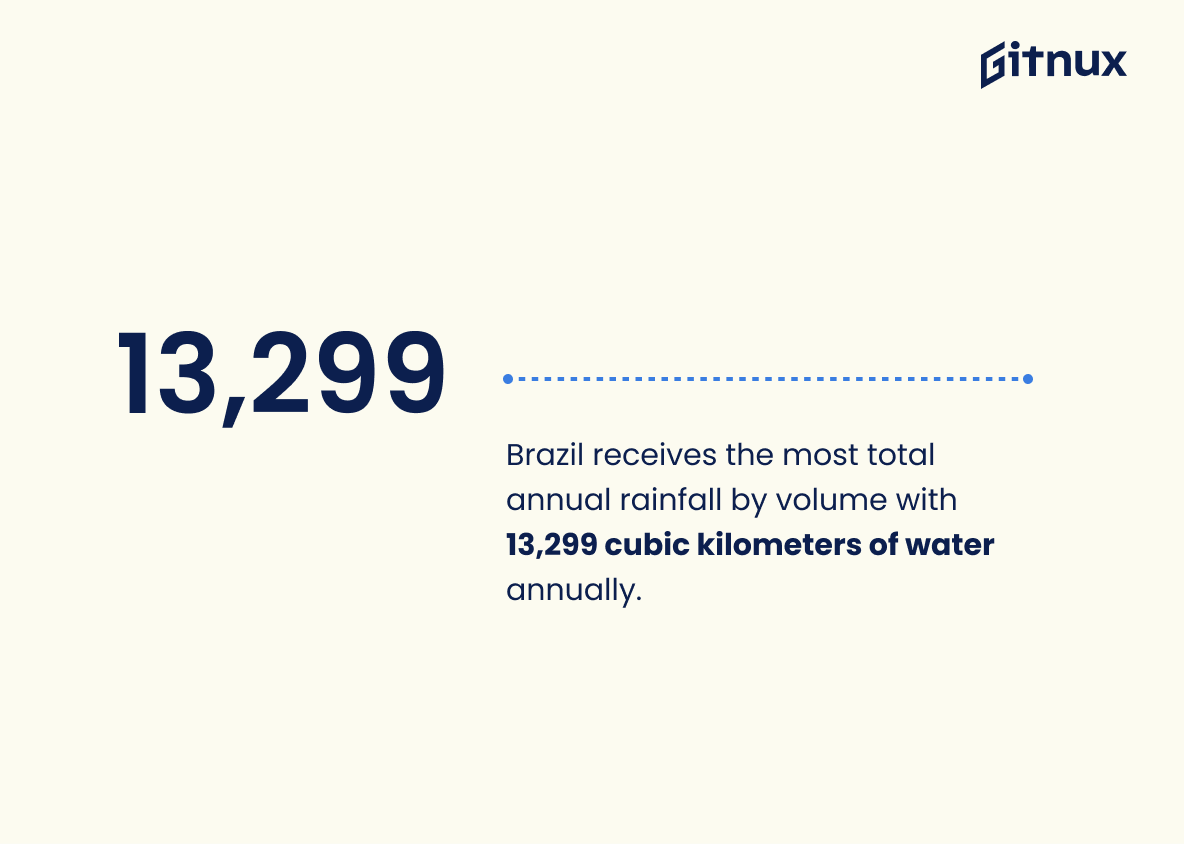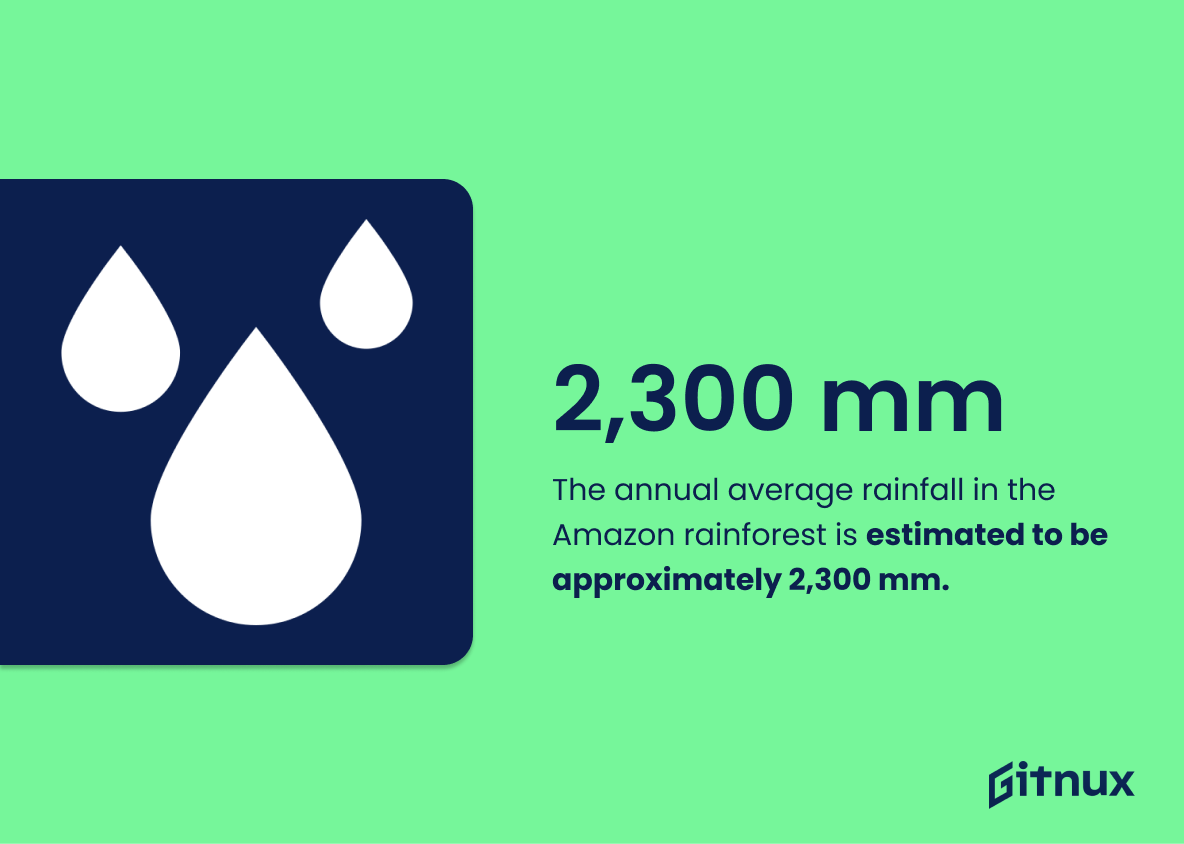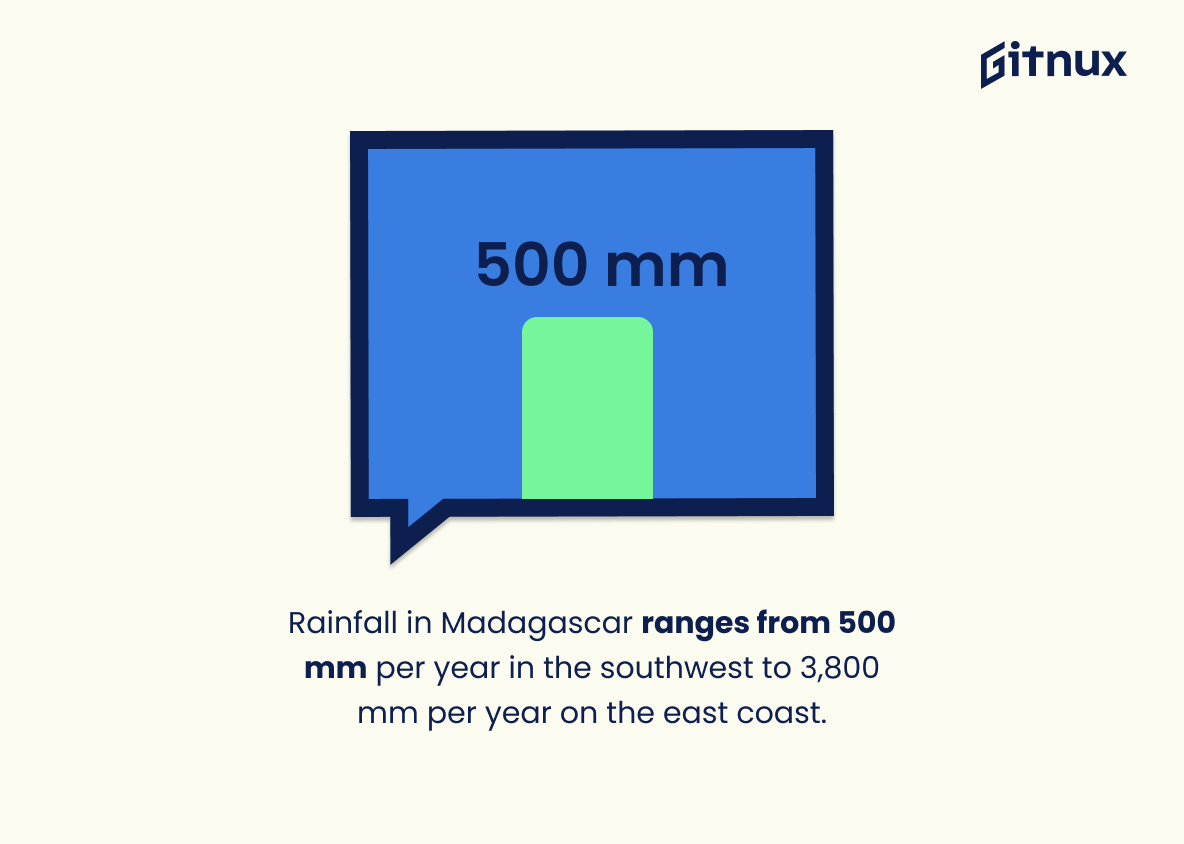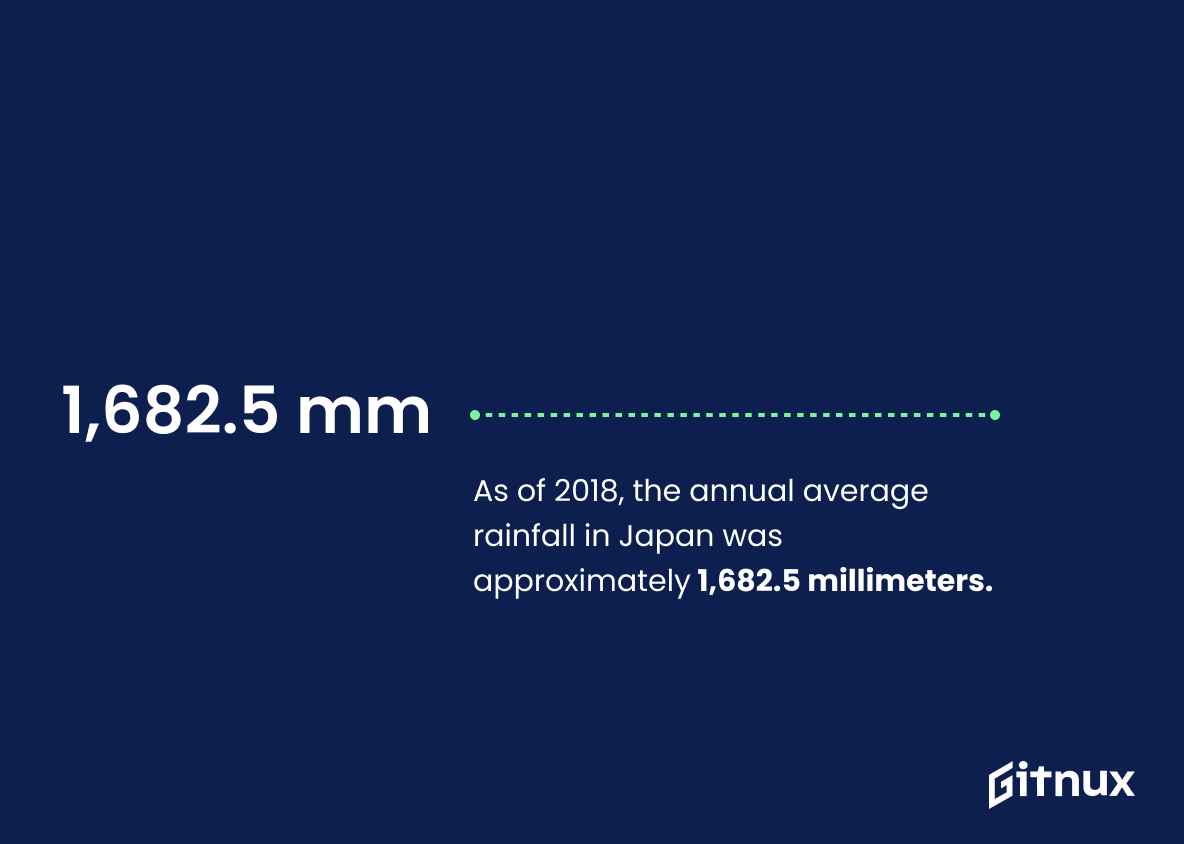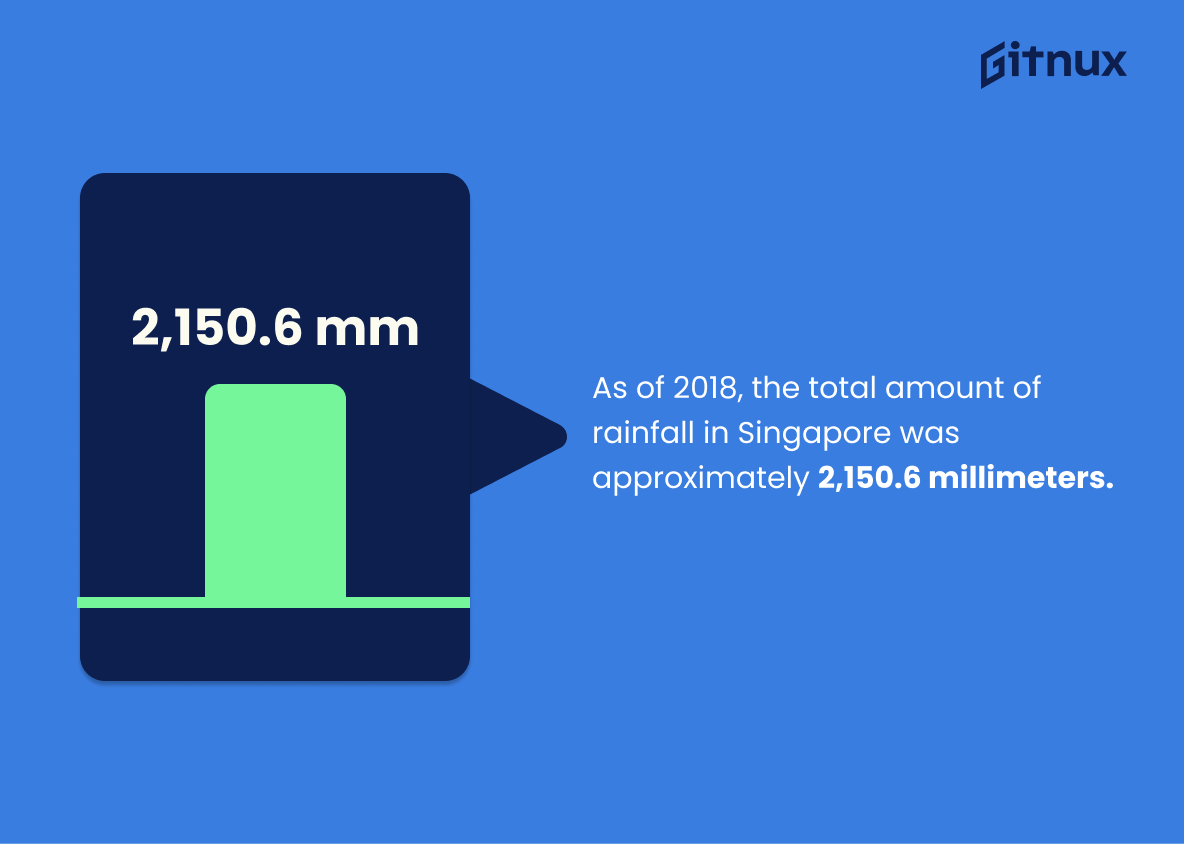Hurricanes, drizzles, downpours, and mist—rain comes in various forms and intensities, adding vitality to our planet and playing a key role in our everyday life. Comprehending the nuances of rainfall isn’t just for the weather enthusiast or the agricultural expert; it is an integral part of understanding the larger picture of our world’s climate system. Welcome to our enlightening journey as we dive into the mesmerizing world of rainfall statistics. Whether you’re a science aficionado examining precipitation patterns or merely an inquisitive reader, this blog post is your comprehensive guide to interpreting, understanding, and appreciating the wealth of data encapsulated in rainfall statistics. So, join us as we turn the drizzle of data into riveting revelations.
The Latest Rainfall Statistics Unveiled
In Mawsynram, a village in India, the average annual rainfall is 11,871 millimeters, making it the wettest place in the world.
Plunging into the heart of global rainfall statistics, Mawsynram, a remote village in India, astonishingly boasts an average yearly downfall of 11,871 millimeters, a staggering saturation rate outpacing any other location on planet earth. Linking this unique numerical reality, we unravel the mystery behind its meteorological moniker – the Wettest Place in the World. An exceptional rainfall record like this enriches the dialogue on precipitation patterns, climatic discrepancies dotting the globe, and provides a remarkable referential cornerstone in the intricate tapestry of global weather patterns. It adds depth and context to our rainy narrative, and serves as a marquee illustration of the extreme end of the global rainfall spectrum. In essence, it’s a watery writ of Mother Nature’s unpredictability that’s fecund and fascinating in equal measure. So, buckle up as we delve deeper into the ethereal world of rainfall dynamics, where Mawsynram is the reigning, yet raining, champion.
The Atacama Desert in Chile has towns where no rainfall has ever been recorded.
Dipping a toe into the intriguing world of rainfall extremes, the Atacama Desert offers a fascinating perspective. Here, in the heart of Chile, towns exist that bear a startling record of receiving absolutely zero rainfall, an intriguing anomaly in global precipitation patterns. Highlighting this distinct phenomenon serves to bolster our comprehension of Earth’s diverse climate conditions, and illustrates the far-reaching extremes in rainfall extremes. By contrasting these drought-stricken areas with the planet’s rain-drenched regions, it provides readers with a stark understanding of global disparity in precipitation, which is an integral part of any discussion on rainfall statistics.
The global average annual precipitation over land is estimated to be about 715 mm.
Delving into the tantalizing tapestry of global rainfall patterns, the statistic revealing an approximate annual average of 715 mm of precipitation over land provides a compelling backdrop. It enhances the readers’ understanding and appreciation of the intricate interplay between the Earth’s climatic processes, moisture distribution, and human survival. It sets the stage for relevant discussion, shedding critical light on regional disparities in rainfall, implications for agriculture, water resources, and overall climate change narratives. Further comparisons can be drawn with this indispensable pivot point to illustrate the real-world impacts of above or below average rainfall years. Essentially, this numerical anchor infuses the blog post with an invaluable global perspective, turning mere rainfall data into engaging, meaningful stories.
In Death Valley, California, US, the average annual rainfall is just 2.36 inches.
Imagine a parched desert landscape, unending sand dunes and soaring temperatures. Yes, we are talking about Death Valley, California, a place where the sky seldom weeps. Each year, the heavens here spare a meager 2.36 inches of tears, transforming it into a land observed from the fine edge of a droplet. This incredible figure forms the core of our discussion on rainfall statistics, offering insight into rainfall variables across the globe. This Death Valley data not only contrasts sharply with more rainy climates, but its lack of rainfall also contributes to its intrinsic hostile yet intriguing characteristics. Therefore, when delving into a topic like rainfall statistics, it’s essential to include such striking examples to highlight nature’s astonishing variations.
In London, UK, the average annual rainfall is 601 millimeters.
The annual precipitation of 601 millimeters in London, UK is a poignant figure for any connoisseur of rainfall statistics. This needle in the haystack data, manifests the city’s climate intricacies and offers invaluable insights into its annual weather cycles. For those with a special interest in England’s capital, it paints a vivid meteorological picture, revealing that the city witnesses less rain than one might assume, considering its famed reputation for drizzly days. Not just that, it also provides an essential reference point, enabling fascinating global comparisons, thus cementing why rainfall data is such a celebrated area within the vast spectrum of statistical studies.
In Bergen, Norway, more than 200 days per year see rainfall, with an annual average of 2,250 mm.
Delving into the vivid rain-drenched narrative of Bergen, Norway, we unveil a city that experiences rainfall on over 200 days a year. Bergen, popularly known as the rain capital of Europe, paints a profound picture for any rainfall statistic analysis. Drenched annually, on average, in a staggering 2,250 mm of rainfall, it significantly contributes to our understanding of the global rainfall distribution. These averages highlight the city’s key role in examining patterns in heavily rainfed regions of the world, influencing the climate model projections. Hence, such numbers form integral plot points in a blog post about Rainfall Statistics, creating critical base data for realistic comparisons and in-depth analysis.
The Australian annual average rainfall for 2019 was 277 mm, well below the 1961–1990 average of 465 mm.
Unveiling the narrative behind these numbers, the great tumble from an average of 465mm during 1961—1990 to a mere 277mm in 2019, casts a rather disquieting spotlight on Australia’s climate story. This figure, a silent whisper of profound climatic transformation, invites us to delve deeper into the realms of rainfall patterns, their past trends, and future predictions. Within the scope of a blog post on Rainfall Statistics, it brings forth thought-provoking discussions about long-term shifts in Australian weather patterns, implications on agricultural productivity, water supply, and even life quality. In essence, these numbers serve as a dramatic prologue, subtly emphasizing the significance of statistical analysis in understanding and potentially combating climate change.
Brazil receives the most total annual rainfall by volume with 13,299 cubic kilometers of water annually.
Immersing ourselves in the cascade of numbers, we discover an intriguing gem: Brazil tops the charts by receiving a thumping 13,299 cubic kilometers of watery gift annually. Indeed, this saturation of enlightening fact adds depth to the overall narrative about rainfall statistics. This data not merely documents Brazil’s stature as the globe’s most drenched nation, but also underscores the vast geographical variations in rainfall volumes. The linkage of this tremendous downpour to Brazil’s endlessly vibrant biodiversity, river systems, and agriculture, amplifies its significance. Moreover, it hints at the vital role Brazil plays in Earth’s water cycle, triggering a ripple of insights about environmental science, climate patterns, and global ecological balance.
Hawaii, USA has the most diverse rainfall in the world where it ranges from 460 mm to over 10,000 mm per year.
Gauging the significance of this statistic, it sparks a fascination in the vastly diverse terrain and climate conditions within Hawaii, USA, which result in such an extensive range in annual rainfall. It makes a compelling case study for global rainfall patterns as it practically encapsulates all types of climatic conditions – from extreme aridity at one end to hyperhumid at the other, within just one American state. Not only does it enrich a blog post on Rainfall Statistics with fascinating data, but it also provides an intriguing hook to engage readers, making them curious to understand more about the complex nature of global rainfall distribution.
In 2019, Belgium had a total rainfall of about 852 mm.
Fully grasping Belgium’s 2019 precipitation volume of approximately 852mm offers valuable insights within our rainfall exploration. It lays down a comprehensive picture of the nation’s climatic behavior, acting as a reference point against global averages. By integrating this information, reader’s outlook is broadened, creating an understanding of how variations in these figures can impact everything from agriculture, water supply, to further influencing economy and lifestyle. This statistic paints a vivid portrait of Belgium’s climate narrative, representing a fundamental piece in the puzzle of global meteorological patterns analysis.
The annual average rainfall in the Amazon rainforest is estimated to be approximately 2,300 mm.
Encapsulating the geographical meteorology into numerical details, the assertion of the annual average rainfall in the Amazon rainforest standing at approximately 2,300 mm paints a vivid picture of its ecosystem. This hefty amount of precipitation serves as the backbone of global weather flows. Within the context of a blog post about Rainfall Statistics, it becomes a crucial data reference, shedding light on the maximum extents of rainfall. Further, it enables inclusive discussions about the climatological patterns and global humidity contributions. Notably, it highlights the “lungs of the Earth” (Amazon rainforest’s), vital role in setting the bar high for rainfall parameters, which in turn affects its biodiversity and our planet’s atmospheric balance. This measure of the Amazon’s annual precipitation adds a compelling deep dive into understanding the world’s rainfall mechanics, offering readers a richer and more diverse understanding of global rainfall distribution.
Rainfall in Madagascar ranges from 500 mm per year in the southwest to 3,800 mm per year on the east coast.
In peeling back the layers of our planet’s complex environmental patterns, this compelling evidence regarding rainfall in Madagascar paints a wide-ranging portrait of just how diverse a single geographical location can be. Spanning a sizeable spectrum of 500mm to 3800mm of annual precipitation, it underscores the fact that rainfall distribution doesn’t uniformly blanket even a singular country like Madagascar. For scholars of rainfall data, it provides a fascinating case study. These significant disparities from the southwest to the east coast elevate the importance of localized climate assessments, assisting in formulating tailored agricultural practices, water management, and climate change initiatives. Thus, this dynamic statistic illuminates the wider tableau of global rainfall patterns, offering readers further insights into the realm of climatology.
As of 2018, the annual average rainfall in Japan was approximately 1,682.5 millimeters.
The deluge of intrigue around Japan’s annual average rainfall of approximately 1,682.5 millimeters in 2018 fuels useful insight when knee-deep in examining worldwide Rainfall Statistics for our blog post. Not just a drizzle of data, this figure serves as a crucial rain gauge, helping us compare Japan’s aquatic abundance with other climes globally. It also sets the stage for analyzing temporal patterns in the Land of the Rising Sun’s rainfall, discussing its implications on various related sectors such as agriculture, water management, and disaster planning. So don’t just pack your umbrella yet, let’s plunge deeper into the data puddles together.
As of 2018, the total amount of rainfall in Singapore was approximately 2,150.6 millimeters.
Painting a vivid picture of Singapore’s rainfall patterns, the 2018 data of around 2,150.6 mm provides a surprising insight. This whopping figure teases out the inherent wet and humid climate of this Southeast Asian city-state, demonstrating that when it comes to rainfall, Singapore is not a destination to underestimate. The importance of this hydration cannot be overstated – it feeds into every aspect of Singapore’s life, affecting everything from its incredibly green landscapes, water supply, agriculture, to even its temperature range. Therefore, this number serves as a critical reference point for both historical and future rainfall patterns in weather evaluation or climate change discussions.
Conclusion
In conclusion, understanding rainfall statistics is not just for meteorologists or climate scientists, but they bear significance to every individual. These statistics provide invaluable insights into weather patterns, enable more accurate weather forecasts, and play a crucial role in environmental planning and management. Considering the increasing effects of climate change, it is essential to broaden our understanding of such statistics. We must appreciate their influence and the critical part they play in agriculture, water management, and overall sustainability of our planet. Remember, every drop counts and knowing just how much is falling can make all the difference.
References
0. – https://www.www.metoffice.gov.uk
1. – https://www.www.fao.org
2. – https://www.www.britannica.com
3. – https://www.www.guinnessworldrecords.com
4. – https://www.www.nps.gov
5. – https://www.www.rainforestconcern.org
6. – https://www.www.lifeinnorway.net
7. – https://www.www.statista.com
8. – https://www.www.bom.gov.au
9. – https://www.www.worldatlas.com
